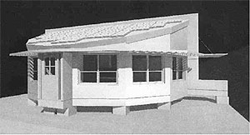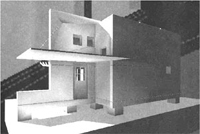|
The University of Delaware is one of 14 universities in the nation selected to participate in the U.S. Department of Energy’s 2002 Solar Decathlon. Student teams at the 14 schools are each designing and building a fully self-sufficient solar house that will be displayed in a “solar village” on the National Mall in Washington, D.C., beginning Sept. 20.
Student teams are responsible for every aspect of the competition, which comprises 10 events, including lighting, refrigeration, comfort and design and livability. During the event, only the solar energy available within the perimeter of each house may be used to generate the power needed to compete in the contests.
More than 50 students and faculty advisers at UD are currently working on the 800-square-foot house. Construction of UD’s entry is expected to begin in April on the Newark campus.
According to Lian-Ping Wang, associate professor of mechanical engineering and project leader, the objective of the competition is to demonstrate new technologies to an energy-conscious nation.
 “Solar power is a viable energy alternative to fossil fuels,” he said. “Electricity shortages and rolling blackouts like the ones experienced in California have become major national energy concerns. Our goal is to showcase solar energy as a feasible supplement to our nation’s strained energy resources.” “Solar power is a viable energy alternative to fossil fuels,” he said. “Electricity shortages and rolling blackouts like the ones experienced in California have become major national energy concerns. Our goal is to showcase solar energy as a feasible supplement to our nation’s strained energy resources.”
Integrating architectural design with engineering, a key DOE objective, proved to be a major challenge to the UD team, as the University does not have an architecture school or program. “We felt qualified to address the issues involved with the design of mechanical systems,” Lauren Leonard, a UD senior in engineering from Wilmington, said, “but we knew little about construction materials, supports, roofing, drywall and so on.”
Another major challenge facing the team as the project began was fund-raising. DOE provided seed money, but the team needed resources far exceeding that initial funding.
Both of these challenges have been largely surmounted. Solar Decathlon Fellowships were established to enable a core group of students to devote their time to the project during the University’s Winter Session. The team sought the expertise of professionalsæincluding architect Hank Pierce, Moeckell Carbonell Associates Inc.; structural engineer Robert MacIntosh, O’Donnell Naccarato MacIntosh; engineer John Leslie, Delaware Engineering and Design Corp.; Pat Martin, technician, and Jörn Jürgens, product manager, both at AstroPoweræwho donated their services when they learned about the project.
The firms with which they are affiliated joined an ever-growing list of sponsors who have donated everything from money and expertise to building materials, the solar electric power system and mechanical and electrical systems.
“We are extremely fortunate to have the support of so many sponsors,” Wang said, “including experts in the field who were willing to mentor students. They have become an integral part of our team, and this project is truly a team effort.”
AstroPower, a Newark, Del.-based solar energy company, is not only donating the entire photovoltaic electric power system and batteries but also supporting the team on technical questions and will help to mount the system on the final solar house. Other major sponsors include Eco-Thermal Panel Systems, which is donating insulated wall and roof panels; DuPont, which has provided much-needed funding; and Hardcore Composites, which is donating a floor system.
The team is adopting a two-part approach to energy conservation: first, converting solar energy to electricity using photovoltaic solar cells and, second, harnessing the sun’s thermal energy directly for heat and hot water. Wang emphasized that the requirements are more extensive than just heating and cooling, including, for example, generating enough power to run a computer-based home business and operate an electric car.
 Communication is an important part of the project and is one of the individual events in the decathlon. “One of DOE’s main goals is educating the public,” Ajay Prasad, associate professor of mechanical engineering and adviser to the American Society of Mechanical Engineers (ASME) student chapter at UD, said. “To design a good solar house, you have to think differently, and it’s going to be important for these students to articulate and graphically communicate the concepts that went into the design and operation of the house.” Communication is an important part of the project and is one of the individual events in the decathlon. “One of DOE’s main goals is educating the public,” Ajay Prasad, associate professor of mechanical engineering and adviser to the American Society of Mechanical Engineers (ASME) student chapter at UD, said. “To design a good solar house, you have to think differently, and it’s going to be important for these students to articulate and graphically communicate the concepts that went into the design and operation of the house.”
Wang said a number of educational benefits will result from participation in the Solar Decathlon. “Students will learn architectural design and practice, energy conservation and sustainability, and solar electricity and solar thermal concepts, as well as teamwork across disciplines,” he said. In addition, the project will be integrated into the engineering curricula through several courses. After the competition, the solar house will be re-erected on campus, where it will be used for research, teaching and recruitment.
The UD Solar team is still seeking donations of money, materials, and expertise to help in converting the dream of a solar house to reality. Students from other disciplines, such as civil engineering, electrical and computer engineers, computer and information sciences, bioresources engineering, plant and soil sciences, communication, business administration, economics, consumer studies, urban affairs and public policy and hotel, restaurant and institutional management, are being sought for the team.
Interested students and potential donors should contact Wang at [lwang@me.udel.edu] or Leonard at [lrlenn@udel.edu].
Feb. 19, 2002
|

